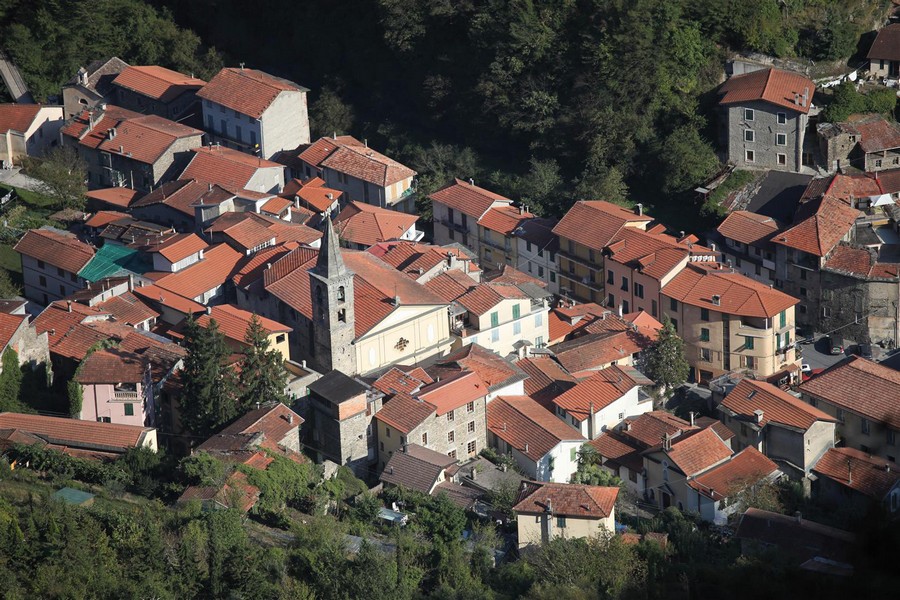Altitude: 460 m a.s.l.
Area: 58 sq km
Distance from Imperia: 40 km
Inhabitants: in 1881: 3022 - in 2017: 611
Patron Saint Day: August 10th - San Lorenzo
Information: Municipality phone 0184 94014
The first inhabited center was built before the year one Thousand around the mills at the bottom of the valley; in 1331 Molini passed under the dominion of Carlo Grimaldo, Lord of Ventimiglia, and therefore followed the fate of Triora.
Visit of the town
Arriving to the square where the town hall stands, turn right and park.
Continuing on foot in the same direction, reach at the bottom of the village the oratory of Sant'Antonio da Padova with a small bell gable at the top of the facade; it preserves inside, between the two spiral columns on either side of the Baroque altar, the painting of the Virgin with Child and on the left an anonymous canvas of Saint Anthony.
Returning back, climb the stairway and, past the vault, you’ll find on the left the oratory of Sant'Antonio Abate and Maria Maddalena, seat of the “Confraternita dei Battuti”, and on the right the parish church of San Lorenzo Martire.
The oratory has a black stone portal with jambs decorated with rosettes and an architrave carved with angels' heads on the sides and surmounted by an aedicule, a work of 1615 by Jacopo Alessandro di Cenova.
On the right side there is a small fountain with a small basin carved out of a capital supported by its column, a remnant of the original church as well as the column affixed upside-down in the corner of the opposite house.
The opposite church of San Lorenzo was in fact built with a beautiful stone bell tower at the end of the fifteenth century but was later rebuilt in Baroque style in the seventeenth century and again restored in the following century.
The portal is in smooth stones, cut into a braid in the jambs; of the original construction remains, affixed on the façade on the left of the portal, part of the monolithic architrave of 1486 carved with a Trigram in a sunburst pattern. On the right side opens the smooth-stone side door.
The most significant work preserved in the church is the mutilated polyptych "Santa Maria Maddalena con Santa Marta e Santa Lucia", dated 1540, by Emanuele Macario da Pigna; behind the high altar is the anonymous canvas "Martyrdom of San Lorenzo".
Continuing to climb beyond the church, pass next to the monument to the Blessed Giovanni Lantrua martyr, born here in 1760. After the fountain of 1899, continue along Via Case Soprane; after the nineteenth-century portal at number 8, upon reaching the junction, turn left following the sign to Triora.
Once past the small loggia with seats that houses a fountain with a stone basin, you’ll find the Santuario della Montà, a 13th and 15th centuries building near the cemetery.
The left side door is in smooth stone, with the date 1555 engraved on the architrave; the right one is protected by a roof that rests on sturdy shelves in black stone.
The interior, frescoed in the fifteenth century by Antonio Monregalese with medallions representing the four Evangelists and saints, preserves in a small temple frame an anonymous canvas of the "Virgin and Child" of 1605 and another one of 1613 dedicated to Sant'Anna.
Going back to the oratory of Sant'Antonio, you can take Via Lantrua on the right to see, a hundred meters further on, the bare oratory dedicated to the same Saint.
After descending to the Provincial Road, continue on foot to the right and take, three hundred meters after the town hall, the ramp that descends on the left leading to the Baroque oratory of San Bernardo of 1638, flanked by a fountain with a basin supported by a capital.
The architrave of the portal, carved in a Trigram, is surmounted by the niche in black stone which houses the marble statue of the saint; along the inner walls are the archaic stone seats, while outside on the left side are visible the large river boulders used for the construction.
Further upstream, in the Armetta area, stands the "Rocca dè Basue", a meeting point for the witches who in the sixteenth century infested the area.
On the first of November takes place the festival of the chickpea soup, which was considered food for the dead as in other areas of the hinterland.
Back to the car, continue along the Provincial Road to reach Triora.


